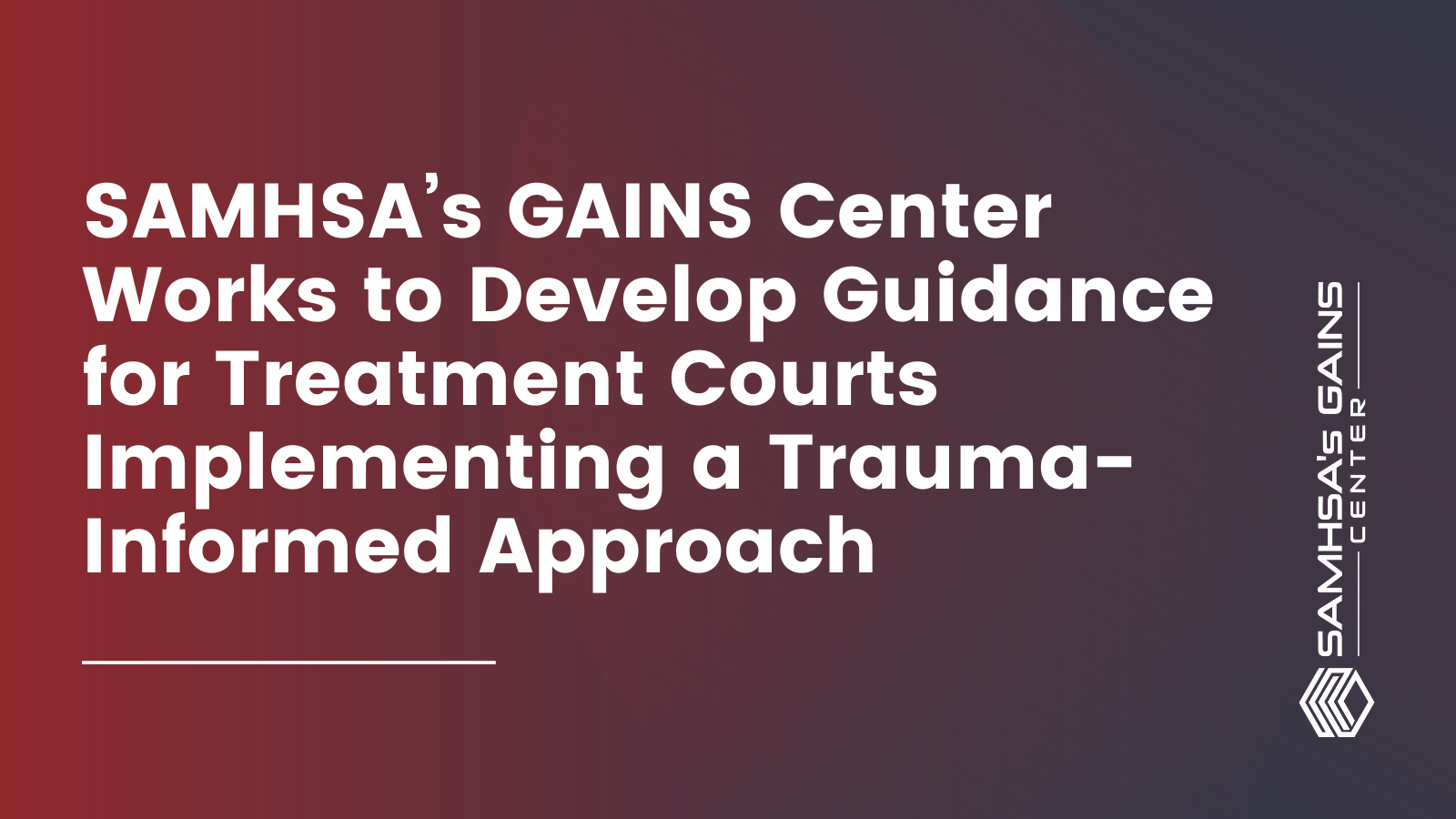Being trauma informed means understanding that past experiences can profoundly affect individuals’ functioning and mental, physical, social, emotional, or spiritual well-being.[1] Trauma-informed systems recognize the impact of trauma and respond by fully integrating knowledge about trauma into policies, procedures, and practices.[2] After learning about trauma-informed practices, courts have requested additional guidance on implementing these practices in treatment court settings. In 2023, SAMHSA’s GAINS Center engaged in a three-part process to develop and update existing guidance for trauma-informed treatment courts.
Starting in January, the GAINS Center produced a webinar on how trauma-informed practices can maximize the effectiveness of treatment courts and the court staff. Then, in March, SAMHSA’s GAINS Center and All Rise co-hosted a panel of 50 experts to help inform the development of guidance and recommendations for treatment courts. The expert panel, which was composed of key treatment court team roles, engaged in a facilitated dialogue to capture multiple perspectives on the issue and inform the development of practice recommendations through multiple lenses. Then, in June, All Rise and SAMHSA’s GAINS Center held a series of sessions at the All Rise conference. These sessions provide opportunities for the field to reflect on and respond to the expert panel’s recommendations.
SAMHSA’s GAINS Center is now working to review and synthesize the expert panel recommendations and the feedback from All Rise conference participants as the critical next step in developing and releasing guidance and recommendations to the field. This article provides an initial summary of the work and some preliminary findings.
Implementation Domains of a Trauma-Informed Court
For courts interested in implementing a trauma-informed approach, SAMHSA’s Concept of Trauma and Guidance for a Trauma-Informed Approach offers a starting point using 10 implementation domains. During the SAMHSA’s GAINS/All Rise workshops, treatment court professionals across roles responded to SAMHSA’s Center for Substance Abuse Treatment expert panel recommendations for implementing a trauma-informed treatment court. The following summarizes findings on the first three domains: Governance and Leadership, Policy, and Physical Environment.
Governance and Leadership
Support for a trauma-informed approach must be present at the highest level of the court to be truly successful. A public commitment from judges and other leadership, investment of money and time, regular, open communication, and building of trust across all levels of the court are critical. Leadership must communicate their support and guidance for this approach. This includes verbal support and tangible actions that demonstrate a commitment to trauma-informed services and supports.
One way to show this commitment is by including accountability standards in the court’s written policies and procedures that explicitly outline their dedication to providing trauma-informed services. This helps to set the tone and expectations for all staff members, system partners, and individuals involved in the court system.
In addition, it is important to ensure that the voices and perspectives of people who have experienced trauma are heard and valued within the court system. This can be achieved by creating structures within judicial leadership and court governance that support the participation of these individuals. By actively seeking and incorporating their feedback and ideas, the court can better tailor its services and support to meet the unique needs of those who have experienced trauma.
Implementing a trauma-informed approach in the court system requires a multifaceted approach that involves leadership support, policy changes, and a commitment to inclusivity and participation.
Policy
A treatment court should have documented policies that reflect the six guiding principles to a trauma-informed approach. They should include policies addressing the risks and impacts of trauma for individuals engaged with the treatment court team and other agency staff. Judges, court administrators, prosecutors, and public defenders are important treatment court team members.
The Six Guiding Principles to a Trauma-Informed Approach
1) Safety
2) Trustworthiness & transparency
3) Peer support
4) Collaboration & mutuality
5) Empowerment & choice
6) Cultural, historical & gender issues
Additionally, implementing a trauma-informed approach in the court system requires following several key policy recommendations. These include recognizing the pervasiveness of trauma in people’s lives and engaging in strategies to prevent re-traumatization while promoting well-being and recovery. It is essential to demonstrate a commitment to staff orientation and in-service training that is culturally relevant and trauma informed. This will help to ensure that staff are equipped to provide services and support that meet the unique needs of those who have experienced trauma.
It is also important to address the impact of working with people who have experienced trauma and provide resources to respond to vicarious or secondary trauma, burnout, and compassion fatigue. By doing so, staff will be better able to manage the emotional demands of their work and provide effective support to those seeking help.
Furthermore, it is recommended to include trauma survivors, people receiving services, and peer support in planning, governance, policymaking, services, and evaluation. This will help to ensure that the voices and perspectives of those who have experienced trauma are heard and valued and that the court system is better equipped to tailor its services and supports to meet their unique needs.
Finally, it is crucial to consider safety and confidentiality. This can begin with language in the court’s mission statement and written policies that explicitly outline dedication to creating structures within the court system that support and protect individuals who have experienced trauma.
Physical Environment
The physical environment of the treatment court should foster safety to the greatest extent possible. Individuals with lived experience of trauma should always be involved in assessing and making recommendations for improving the environment to help reduce re-traumatization. This might include strategies such as well-lit buildings, clear and welcoming signage, and sufficient amplification to ensure that what is said is heard and understood.
To create a trauma-informed physical environment, courts should consider a few recommendations. Firstly, creating a calm, safe space that minimizes potential triggers is essential. This can be supported with neutral colors, natural lighting, and simple decor. Additionally, it is vital to allow for privacy and confidentiality in waiting areas and courtrooms.
Another recommendation is to provide resources and support for individuals who have experienced trauma. This can include access to mental health professionals, support groups, therapy dogs, and informational materials. Training court staff on trauma-informed practices and how to interact with individuals who have experienced trauma is also important.
Finally, the physical environment should be accessible and accommodating for individuals with disabilities and other needs. This can include providing wheelchair accessibility, captioning services, and interpreters. To the extent possible, engaging courthouse security staff in partnership and training can help improve the court experience for people with a trauma history. Security screenings and searches should be conducted gently and with notice to ensure a person’s feeling of safety and respect when arriving at court.
Next Steps and Where to Learn More
SAMHSA’s GAINS Center will work with All Rise to release a complete summary of recommendations and guidelines for implementing a trauma-informed treatment court in Winter 2023–2024. In the meantime, the following resources provide more information on the best practices for becoming a trauma-responsive treatment court.
- SAMHSA’s GAINS Center Webinar: A Holistic Trauma-Informed Approach for Every Treatment Court Role: Maximizing Team Members’ Effectiveness in Interpersonal Interactions (January 26, 2023)
- SAMHSA Publication: SAMHSA’s Concept of Trauma and Guidance for a Trauma-Informed Approach
- SAMHSA Publication: Practical Guide for Implementing a Trauma-Informed Approach
- National Drug Court Resource Center Resource: Trauma-Informed Practices
- SAMHSA’s GAINS Center Resource: Treatment Court Locators
- All Rise Publication: Adult Drug Court Best Practice Standards
References
[1] National Drug Court Resource Center. (2023). Trauma-informed treatment courts: Translating knowledge into action. https://ndcrc.org/trauma-informed-treatment-courts-translating-knowledge-into-action/
[2] SAMHSA. (2014). SAMHSA’s concept of trauma and guidance for a trauma-informed approach. https://ncsacw.acf.hhs.gov/userfiles/files/SAMHSA_Trauma.pdf
Like what you’ve read? Sign up to receive the monthly GAINS eNews!


